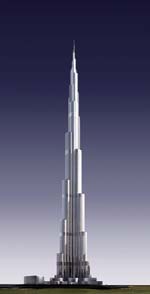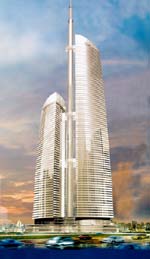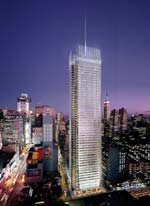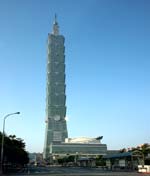

Home Site Search Contact Us Subscribe
|
|
|
|
The Rise of the Few: Key Ingredients for the World's Tallest Skyscrapers
Q&A with Ron Klemencic, Chairman, Council on Tall Buildings and Urban Habitat by Linda Crites September 27, 2005 In the search of power, prestige, and profitable returns, developers around the world are commissioning the next great skyscraper. But despite the potentially striking skylines and intricate details, few plans actually get off the drawing board. And of those that do, few buildings achieve their promised, record-setting heights. So why are some projects successful and others not?
As president of Seattle- and Chicago-based Magnusson Klemencic Associates, Ron Klemencic has worked on more than 100 high-rise, mixed-use structures in 11 countries. As chairman of the Council on Tall Buildings and Urban Habitat, Klemencic is bringing together the world's tall building experts – specialists in technology, finance, and architecture – for the Council on Tall Building’s 7th World Congress, October 16-19 in New York City, themed "Renewing the Urban Landscape.” (The Congress registration deadline is imminent; click on link for program and registration details.)
Klemencic believes certain characteristics help skyscrapers to reach their promise. They include cultivated public support, deep commitments by financial backers, and winning designs. In the following interview, Klemencic offers thoughts on the business of skyscrapers – why some skyscrapers successfully emerge and why others, that looked vital, failed to get off the ground. He also talks about the impact of terrorism on the world’s tallest buildings, the technology that will help new structures stand, and where tall buildings will emerge in the next decade.
Q: After the 9/11 tragedy some predicted an end to the skyscraper. Has there been a shift in thinking? Ron Klemencic: The aversion to building tall has decreased, though there still is a lingering concern over very prominent, very tall office buildings. But people have realized that we live in this free and open society, and we have to maintain our lifestyle as before, and that means living and working in tall buildings.
Q: What exactly is a tall building? RK: Technically, according to many fire departments, tall is anything over 75 feet. That's only about six stories high. Industry experts and developers are pushing the definition – and the envelope – with buildings of 2,000 feet or more.
Super-tall buildings typically rise higher than 80 stories; however, not everyone agrees how to determine the height. The Council on Tall Buildings defines height by the architectural top of a building, which includes features integral to a design, like spires, but not antennas. If you take off the top of the Chrysler Building, it doesn’t look like the Chrysler Building anymore. But if you take the antennas off the Hancock Tower, it still looks like the Hancock Tower.
Q: Will the proposed Freedom Tower be one of the world’s tallest? RK: There will be a heated debate surrounding the Freedom Tower as to whether the majority of the building can be considered occupied. The Freedom Tower’s spire tops out over 600 feet above the last floor of enclosed space – that’s about one-third of the building that can’t be occupied. There's a camp that would say that since so much of the structure is not available to be occupied, it should not be considered the tallest building in the world.
What’s particularly interesting about the design of the Freedom Tower is that it may be the first skyscraper designed to a symbolic height, though other buildings, Taipei 101 for example, incorporate lucky numbers.
Q: Taipei 101 is just one of many super-tall structures either recently completed or under construction in Asia. What accounts for the surge? RK: A lot of it has to do with the local governments wanting to put their flag in the ground and say, “We have arrived as an economy.” China, Malaysia, and Taiwan are really trying to establish themselves on the skyscraper playing field. They want to make a statement that they have arrived.
Q: Some would argue the Middle East is racing to overtake Asia. RK: Yes, the race to build super-tall structures has reached epic proportions in Asia and the Middle East. Some insiders say that the Burj Dubai, which is now underway in Dubai, United Arab Emirates, will reach almost a half-mile high. Construction of super-tall buildings is more realistic in those regions where there is no defined street lay-out that can limit floor plate size. You can just build it in the middle of the desert.
Q: Will the Burj Dubai be the world’s tallest skyscraper? RK: Since the developers have not officially released its height, it’s hard to say. However, it certainly will have competition. I’ve been examining exploratory plans for a 130-story building near Seoul, South Korea, that, if built, could challenge or exceed the Burj Dubai.
Q: Why aren’t more tall buildings going up in the U.S.? RK: There are three important reasons for a country to build super tall: national pride, elevating broadcast antennas, and the optimism of developers. The western world has decided we have been there and done that, and it doesn't make a whole lot of economic sense to go higher. Once buildings get above 80 stories or so, they start to lose their economic viability. Beyond 70-80 floors, prestige is the driving factor.
Q: What is the greatest technical challenge facing super-tall buildings? RK: Coping with powerful winds. The new technology allows buildings to sway while an internal damping device absorbs the wind energy and stabilizes the building.
And there are elevator issues. As a building gets taller and taller, you need more and more elevators to move people up and down. Around 70 to 80 stories, the amount of shaft space consumed by the elevators is so great that the economic equation for the building begins to fall apart. In Europe, they’ve recently incorporated new technology that allows two elevator cabs to share the same shaft.
Q: Realistically, how tall can we expect buildings to climb in the coming years? RK: In 1956, Frank Lloyd Wright envisioned a mile-high skyscraper designed to house 100,000 people. And from a technical engineering point of view it could have been done then. Today, from an architectural and engineering perspective, there is no definitive limit to how tall a building can go. Some researchers in Japan, where there’s a well-documented shortage of real estate, have studied the opportunity for mile-high buildings.
Q: Are there other super structures emerging around the world you’re watching, and why? RK: Over the last five years, the list of locations of proposed super-tall buildings has grown rapidly. Moscow, Delhi, Melbourne, Beijing, Shanghai, Seoul, Pusan, Dubai, and even Chicago with the recent announcement of the Fordham Spire, all tout potential record-setting towers. The impact of these towers on the urban fabric as well as the local culture will be interesting to watch.
Q: Is there any one place someone who wants to build the next Empire State Building can learn about tall building issues? RK: At the Council on Tall Buildings 7th World Congress, participants will hear about the challenges of building the world’s tallest skyscraper. The incorporation of green design in tall buildings, the challenges for steel framework, and the NIST’s report on the World Trade Center disaster will also be discussed.
To register for the congress, go to www.ctbuh.org or contact Geri Kery at 312-909-0253.
|
(click on pictures to enlarge)  (Skidmore, Owings & Merrill) Skidmore, Owings & Merrill: Burj Dubai, United Arab Emirates (the height is undisclosed but some experts put it at 2,313 feet) (Turner International) ASP Schweger Assoziierte Architekten/nps tchoban voss architekten: Federation Complex, Moscow (1,115 feet) (Renzo Piano Building Workshop/Fox & Fowle Architects) Renzo Piano Building Workshop/Fox & Fowle Architects: New York Times Headquarters, New York City (1,046 feet) (Turner International) C.Y. Lee and Associates: Taipei 101 (1,671 feet) |
© 2005 ArchNewsNow.com